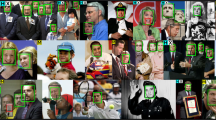Abstract
This paper presents a fast training strategy for the Viola–Jones (VJ) type object-detection systems. The VJ object- detection system, popular for its high accuracy at real-time testing speeds, has a drawback that it is slow to train. A face detector, for example, can take days to train. In content-based image retrieval (CBIR), where search needs to be performed instantaneously, VJ’s long training time is not affordable. Therefore, VJ’s method is hardly used for such applications. This paper proposes two modifications to the training algorithm of VJ-type object detection systems which reduces the training time to the order of seconds. Firstly, Laplacian clutter (non-object) models are used to train the weak classifier, thus eliminating the need to read and evaluate thousands of clutter images. Secondly, the training procedure is simplified by removing the time-consuming AdaBoost-based feature selection procedure. An object detector, trained with 500 images, approximately takes 2 s for training in a conventional 3 GHz machine. Our results show that the accuracy of the detector, built with the proposed approach, is inferior to that of VJ for difficult object class such as frontal faces. However, for objects with lesser degree of intra-class variations such as hearts, state-of-the-art accuracy can be obtained. Importantly, for CBIR applications, the fast testing speed of the VJ type object detector is maintained.





Similar content being viewed by others
Notes
PDF [12] used a simple clutter model, which assumes that the probability of a feature value of a HF, on a clutter image, to be greater/lesser than 0 is 0.5.
References
Viola P, Jones MJ (2004) Robust real-time face detection. Int J Comput Vis 57(2):137–154
Rowley HA, Baluja S, Kanade T (1998) Neural network-based face detection. IEEE Trans Pattern Anal Mach Intell 20(1):23–38
Schneiderman H (2000) A statistical approach to 3d object detection applied to faces and cars: PhD thesis. Carnegie Mellon University, Pittsburgh
Roth D, Yang M, Ahuja N (2000) A SNoW-based face detector. In: Proceedings of the conference on advances in neural information processing systems, Denver, CO, USA, pp 855–861
Pavani S-K, Delgado D, Frangi AF (2009) Gaussian weak classifiers based on Haar-like features with four rectangles for real-time face detection. In: Proceedings of the international conference on computer analysis of images and patterns. Lecture notes in computer science, vol 5702, Münster, Germany, pp 91–98
Li SZ, Zhu L, Zhang Z, Blake A, Zhang H, Shum H (2002) Statistical learning of multi-view face detection. In: Proceedings of the European conference on computer vision. Lecture notes in computer science, vol 2353, London, UK, pp 67–81
Lienhart R, Maydt J (2002) An extended set of Haar-like features for rapid object detection. In: Proceedings of the international conference on image processing, Rochester, New York, USA, pp 900–903
Mita T, Kaneko T, Hori O (2005) Joint Haar-like features for face detection. In: Proceedings of the international conference on computer vision, Washington, DC, USA, pp 1619–1626, doi:10.1109/ICCV.2005.129
Wu J, Brubaker SC, Mullin MD, Rehg JM (2008) Fast asymmetric learning for cascade face detection. IEEE Trans Pattern Anal Machine Intell 30(3):369–382
Stojmenovic M (2006) Pre-eliminating features for fast training in real time object detection in images with a novel variant of AdaBoost. In: Proceedings of the international conference on computational intelligence and security, Guangzhou, China, pp 1–6
Pham M-T, Cham T-J (2007) Fast training and selection of Haar features using statistics in boosting-based face detection. In: Proceedings of international conference on computer vision, Rio de Janeiro, Brazil, pp 1–7
Pavani S-K, Delgado D, Frangi AF (2009) A rapidly trainable and global illumination invariant object detection system. In: Proceedings of the fourteenth Iberoamerican Congress on Pattern Recognition, Guadalajara, Mexico, pp 877–884
Baker S (1998) Design and evaluation of feature detectors: PhD thesis. Columbia University, Columbia
Papageorgiou CP, Oren M, Poggio T (1998) A general framework for object detection. In: ICCV ’98: proceedings of the international conference on computer vision, Washington, DC, USA, pp 555–562
Freund Y, Schapire RE (1995) A decision-theoretic generalization of on-line learning and an application to boosting. In: Proceedings of the European conference on computational learning theory, Jerusalem, Israel, pp 23–37
Huang J, Mumford D (1999) Statistics of natural images and models. In: Proceedings of the international conference on computer vision and pattern recognition, vol 1, Ft. Collins, CO, USA, pp 1541–1547
Hoxmeier JA, Dicesare C (2000) System response time and user satisfaction: an experimental study of browser-based applications. In: Proceesings of the sixth Americas conference on information systems, Long Beach, CA, pp 10–13
Author information
Authors and Affiliations
Corresponding author
Electronic supplementary material
Below is the link to the electronic supplementary material.
Rights and permissions
About this article
Cite this article
Pavani, SK., Delgado-Gomez, D. & Frangi, A.F. Fast training procedure for Viola–Jones type object detectors using Laplacian clutter models. Pattern Anal Applic 17, 441–449 (2014). https://doi.org/10.1007/s10044-012-0309-3
Received:
Accepted:
Published:
Issue Date:
DOI: https://doi.org/10.1007/s10044-012-0309-3




